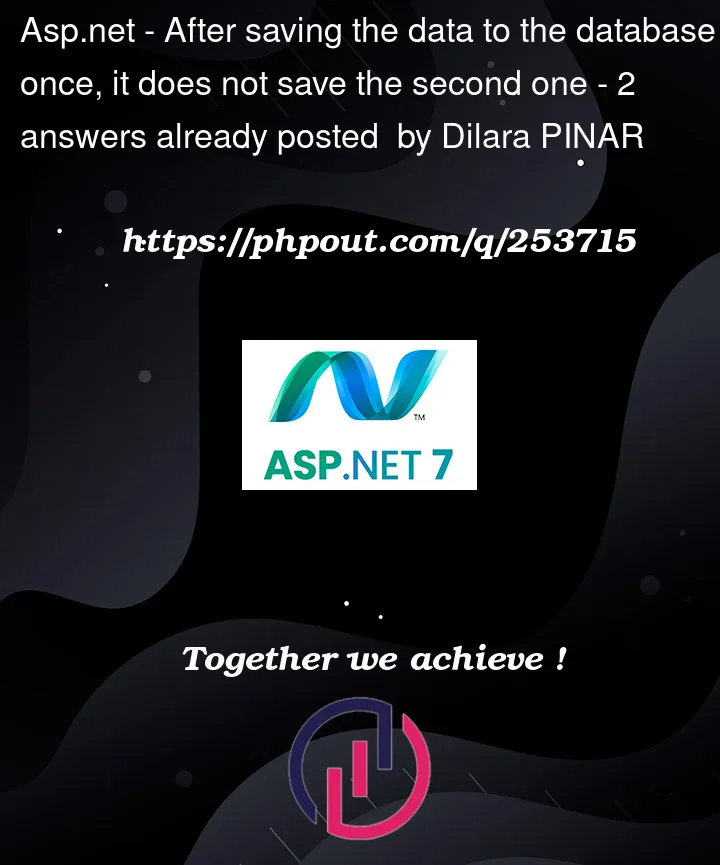I’m pretty new to this industry.
This is the Create method in BaseRepository:
public async Task CreateAsync(TEntity entity)
{
await _db.Set<TEntity>().AddAsync(entity);
await _db.SaveChangesAsync();
}
This is the Create method inside the UserService class.
public ResultService<UserCreateDTO> Create(UserCreateVM userCreateVM)
{
ResultService<UserCreateDTO> result = new ResultService<UserCreateDTO>();
UserCreateDTO createDto = _mapper.Map<UserCreateDTO>(userCreateVM);
User newUser = _mapper.Map<User>(createDto);
var addedUser = _userRepo.CreateAsync(newUser);
if (addedUser != null)
{
result.Data = createDto;
}
else
{
result.AddError(ErrorType.BadRequest, "Ekleme işlemi başarısız");
}
return result;
}
This is our Post method in the API:
// POST api/<UserController>
[HttpPost]
public async Task<ActionResult<UserCreateDTO>> Post([FromBody] UserCreateDTO userDTO, int id)
{
if(userDTO == null)
{
return BadRequest();
}
var user = new User
{
ImagePath = userDTO.ImagePath,
FirstName = userDTO.FirstName,
LastName = userDTO.LastName,
SecondLastName = userDTO.SecondLastName,
BirthDate = userDTO.BirthDate,
BirthPlace = userDTO.BirthPlace,
TcNo = userDTO.TcNo,
DateOfStart = DateTime.Now,
DateOfExit = userDTO.DateOfExit,
CompanyName = userDTO.CompanyName,
JobName = userDTO.JobName,
Department = userDTO.Department,
Address = userDTO.Address,
IsActive = userDTO.IsActive,
Role = userDTO.Role,
PhoneNumber=userDTO.PhoneNumber,
Email = userDTO.Email,
NormalizedEmail = userDTO.NormalizedEmail.ToUpper(),
SecurityStamp = Guid.NewGuid().ToString(),
Password = userDTO.Password,
UserName=userDTO.Username,
NormalizedUserName=userDTO.NormalizedUsername.ToUpper(),
};
UserCreateVM userCreateVM = new UserCreateVM()
{
ImagePath = user.ImagePath,
FirstName = user.FirstName,
LastName = user.LastName,
SecondLastName= user.SecondLastName,
BirthDate = user.BirthDate,
BirthPlace = user.BirthPlace,
TcNo = user.TcNo,
DateOfStart = DateTime.Now,
DateOfExit= user.DateOfExit,
CompanyName = user.CompanyName,
JobName = user.JobName,
Department = user.Department,
Address = user.Address,
IsActive = user.IsActive,
Role = user.Role,
PhoneNumber = userDTO.PhoneNumber,
Email = user.Email.ToUpper(),
NormalizedEmail= user.NormalizedEmail,
SecurityStamp = Guid.NewGuid().ToString(),
Password = user.Password,
Username = user.UserName,
NormalizedUsername=user.NormalizedUserName.ToUpper()
};
var createdUser = _userService.Create(userCreateVM);
if(createdUser != null)
{
return CreatedAtAction(nameof(Get), new { id = userDTO.Id }, createdUser);
}
return BadRequest();
}
As a result of these methods, after saving the user’s data to the database once, it does not perform another save operation, but it appears as if it has been saved in Swagger. I would greatly appreciate it if someone who knows the reason could write about it. I apologize for my English being a bit bad.
I tried to make the ‘Create’ method in the ‘UserService’ asynchronous, but I encountered an error on the line ‘var addedUser = _userRepo.CreateAsync(newUser);’. After fixing the error, I reverted the method back to its original state because I was getting a 500 error in Swagger.




2
Answers
It appears that the problem you’re experiencing is due to how you’re handling asynchronous calls and awaiting the
CreateAsyncfunction in yourUserService. BecauseCreateAsyncis an asynchronous function, you should wait for it to complete before proceeding to guarantee that the user is truly added to the database. Here’s how to change theCreatefunction in theUserServiceclass:By including
awaitbefore_userRepo.CreateAsync(newUser), you ensure that the user creation procedure is asynchronous and complete before proceeding to the next stages in yourCreatefunction. This should remedy the issue where the user does not appear to be saved to the database. To follow the asynchronous pattern, change the return type of yourCreatefunction toTask<ResultService<UserCreateDTO>>. Also, remember to change any calls toCreatein your API code toawait _userService.CreateAsync(userCreateVM). Also, make sure your database context and repository methods (CreateAsync) are set up for asynchronous activities.